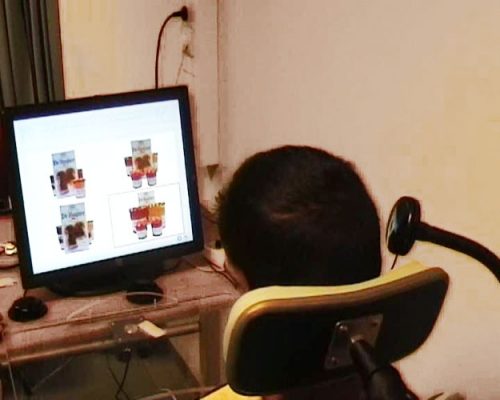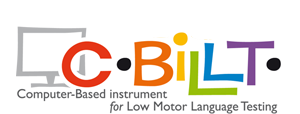
About the C-BiLLT
C BiLLT stands for Computer-Based Instrument for Low motor Language Testing. Administration of the C-BiLLT provides information on the child’s ability to understand spoken language by means of responding to items presented orally by the test leader, and visually on a personal computer.
The C-BiLLT is initialy specifically developed to assess spoken language comprehension in unintelligible or non-speaking children with (severe) motoric impairment caused by cerebral palsy (CP). However, since it’s implementation and use it has shown also to be benificial for assessment of spoken language comprehension in other diagnosis groups (e.g. Down-, Rett-, Angelman- Aicardy Goutieres syndrome). It requires minimal, if any, motor action and is a
psychometrically sound instrument. In other words, the uniqueness and innovation of the C-BiLLT is that children can respond using at least five alternative access method that suits their needs, which includes:
- Touch screen (operated by any body part e.g., hand, foot, nose)
- Input switch(es) that can be adjusted to any body part
- The child’s own wheelchair head rest (used as an input switch)
- Eye gaze (the examiner observes the direction of the gaze and then selects the choice with an external mouse)
- Independent eye gaze computer control with an infrared camera or with an eye control module.
This variety in access methods allows even the most severely motoric handicapped children to respond reliably and unambiguously to the presented tasks of the test. Therefore, the C BiLLT is ideal for diagnostics in unintelligible or non-speaking children with (severe) motor impairments.
Product details
The C-BiLLT provides normdata from the age of 1;6 to 7;0 years. Obviously, the test may be assessed in older children and (young) adults when intellectual disability is suspected. Test results for children younger than 7;0 years are shown in percentile scores and test results for children older than 7;0 years are expressed as age equivalents.The C-BiLLT consists of the following sections:
A pre-test section used to confirm that the child can communicate a choice between two concrete objects. This section is made up of eight familiar items presented by the testleader. The examiner holds two items (the target and a foil) and asks the child to choose the target word spoken (e.g., “where is the ball”). Children can respond by reaching, pointing or using eye gaze. The child is then presented with the same eight familiar items but in photographic form. The child can proceed to the next section (learning module) if they correctly identify at least five objects and/or five photographs.
The computer test consists of 86 items that are presented over two parts.
Part I measures a child’s understanding of noun &, verb phrases of, animals, objects and people.
Part II, the examiner presents 56 spoken sentences with increasing complexity of grammatical structures. For all items in this section, visual feedback regarding the selected response is shown to the child by a red square appearing around their chosen photograph.
